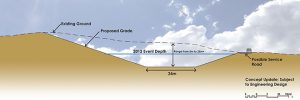CALGARY, ALTA. – The Tsuut’ina Nation in Alberta has formally withdrawn its objection to the Springbank Off-Stream Reservoir (SR1) project after reaching an agreement with the province.
“Our primary concern has always been the protection of our people and our land,” said Chief Roy Whitney, Tsuut’ina Nation. “We have reached an agreement that provides that protection and allows us to mitigate impacts from flooding in the future. The agreement reached is an example of how our governments can work together.”
This month, in letters sent to the Natural Resources Conservation Board and the Impact Assessment Agency, the Tsuut’ina Nation explained that it will no longer participate in the project’s regulatory process.
“The Tsuut’ina Nation is an important partner,” said minister of transportation Ric McIver in a press release. “We committed to meaningfully consult with impacted communities on the Springbank Reservoir, and the withdrawal of the Nation’s objections demonstrates we are doing just that. This marks a major milestone in the regulatory review of the Springbank Reservoir and we are pleased to continue to work with our First Nations partners.”

Alberta Transportation stated that it has consulted with First Nations and Indigenous groups on SR1 since August 2014. Officials said the department will continue to work with other First Nations and Indigenous groups to address their concerns about the project.
The project was designed in response to the 2013 flood to provide flood protection along the Elbow River in Calgary and other downstream communities. Once built, SR1 will become part of a flood mitigation system which includes the Glenmore Reservoir, berms at Redwood Meadows and Bragg Creek.
During a flood, a diversion channel will carry water from the Elbow River to the off-stream reservoir, which would have a storage capacity of 70.2 million cubic metres or about 28,000 Olympic-sized swimming pools. When peak waters have passed, an outlet structure will safely releases the water back to the Elbow River in a controlled manner.
The Springbank Reservoir is designed to work together with the Glenmore Reservoir, which has 10 million cubic metres of available flood storage, to achieve the level of protection required. The channel will be about 4.5 km long and will have a bottom width of 24 metres.











Recent Comments